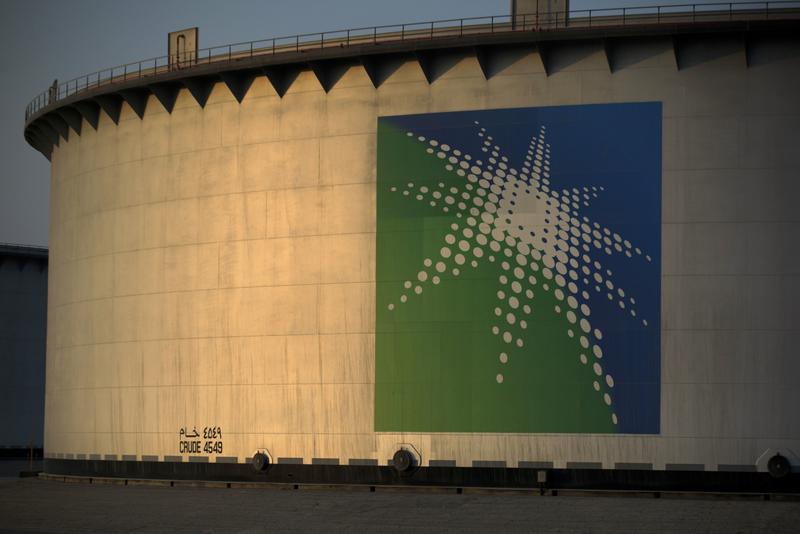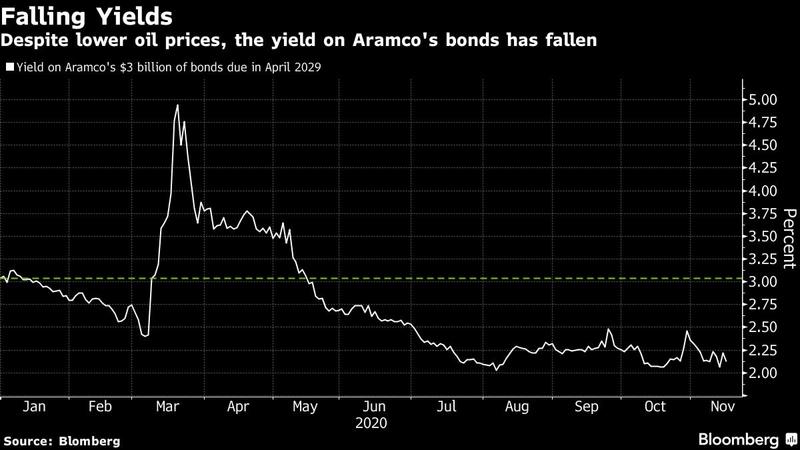 In this Oct 1, 2018 photo, a logo sits on display outside an oil storage tank in the Juaymah tank farm at Saudi Aramco's Ras Tanura oil refinery and terminal at Ras Tanura, Saudi Arabia. (SIMON DAWSON / BLOOMBERG)
In this Oct 1, 2018 photo, a logo sits on display outside an oil storage tank in the Juaymah tank farm at Saudi Aramco's Ras Tanura oil refinery and terminal at Ras Tanura, Saudi Arabia. (SIMON DAWSON / BLOOMBERG)
Saudi Aramco returned to the debt markets for the first time since April of last year, selling US$8 billion of bonds to help fund the world’s biggest dividend.
Saudi Aramco raised US$12 billion in its debut Eurobond sale last year and attracted around US$100 billion of orders
The state oil and gas firm issued the debt on Tuesday after slumping crude prices caused profit to fall by 45 percent in the third quarter. That’s left it unable to generate enough cash to fund shareholder payouts it’s promised will reach US$75 billion this year. Almost all of those will go to the Saudi Arabian government, which needs the money to plug a widening budget deficit and prop up a slumping economy.
Aramco’s deal was the largest from a company in emerging markets this year, according to data compiled by Bloomberg. The firm sold tranches maturing in three, five, 10, 30 and 50 years. Investors placed more than US$50 billion of orders, according to people with knowledge of the matter. Pricing ranged from 1.32 percent for the shortest notes to 3.65 percent for the 50-year portion. The spreads over US Treasures were between 110 basis points and roughly 200.
ALSO READ: Aramco delays oil pricing amid Saudi-Russia row on oil cuts
Benchmark Brent oil has dropped almost 35 percent this year to around US$44 a barrel, with the coronavirus pandemic and lockdowns sapping demand for energy. Despite that, yields in the developed world are so low that investors have rushed to buy highly-rated emerging-market assets, including those of Aramco, the world’s biggest oil company. The yield on the firm’s US$3 billion of bonds due in 2029 has dropped to 2.11 percent from 3.04 percent at the start of 2020. That’s only slightly higher than the rates on the Saudi government’s equivalent bonds.
Tuesday’s deal was also helped by the more bullish sentiment among investors following this month’s progress on coronavirus vaccines. And while some bond traders are wary that US Democrat Joe Biden might regulate oil and gas companies more, Aramco benefits from having such low production costs, according to Todd Schubert, head of fixed-income research at Bank of Singapore.

The Dhahran-based company, rated A1 by Moody’s Investors Service, has slashed spending, cut jobs, and is considering selling some assets as it looks to save money for its shareholder payouts. Despite these efforts, its gearing -- a measure of debt as a percentage of equity -- has increased to 21.8 percent, above its target range of 5 percent to 15 percent. Debt also rose because the company took on loans to pay for a US$69 billion acquisition of Saudi Basic Industries Corp, a chemical maker, earlier this year.
Aramco listed shares on the Saudi stock exchange last December. It pledged an annual dividend of US$75 billion for at least five years after the initial public offering. It may need to tap the bond market again, given the size of those commitments, according to Bloomberg Intelligence.
The dividend pledge has helped prop up Aramco’s shares. They’ve risen 0.7 percent this year, while those of rivals such as BP Plc and Royal Dutch Shell Plc have fallen more than 40 percent.
READ MORE: CEO: Saudi Arabia has asked Aramco to boost oil capacity
Still, Saudi Arabia’s reliance on Aramco to support its fiscal needs will weigh on the company’s balance sheet and “risks placing increasing stress on its credit profile,” said Jaimin Patel, a BI analyst.
The lead banks on Tuesday’s bond sale were Citigroup Inc., Goldman Sachs Group Inc, HSBC Holdings Plc, JPMorgan Chase & Co, Morgan Stanley and NCB Capital.
Aramco raised US$12 billion in its debut Eurobond sale last year and attracted around US$100 billion of orders.


